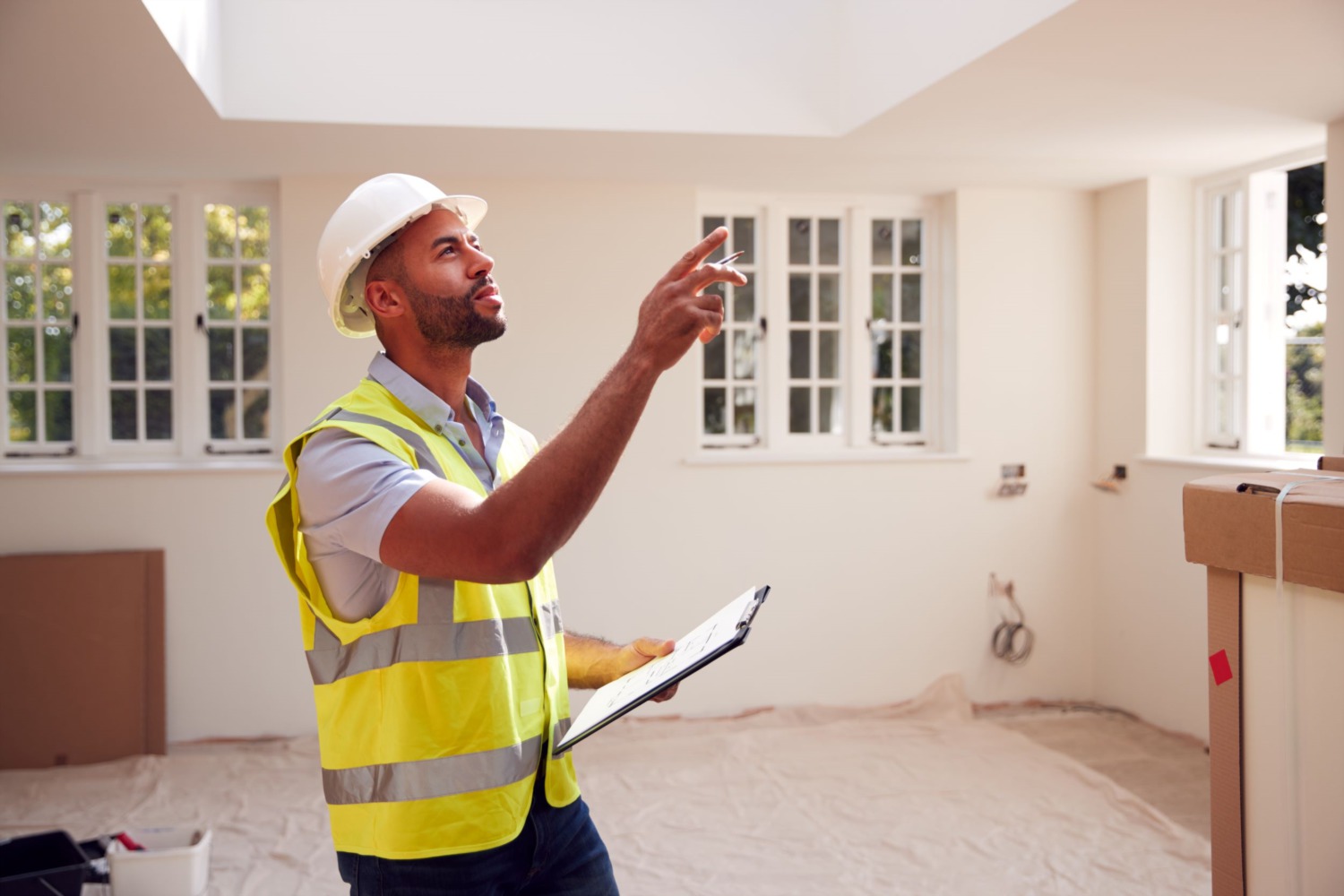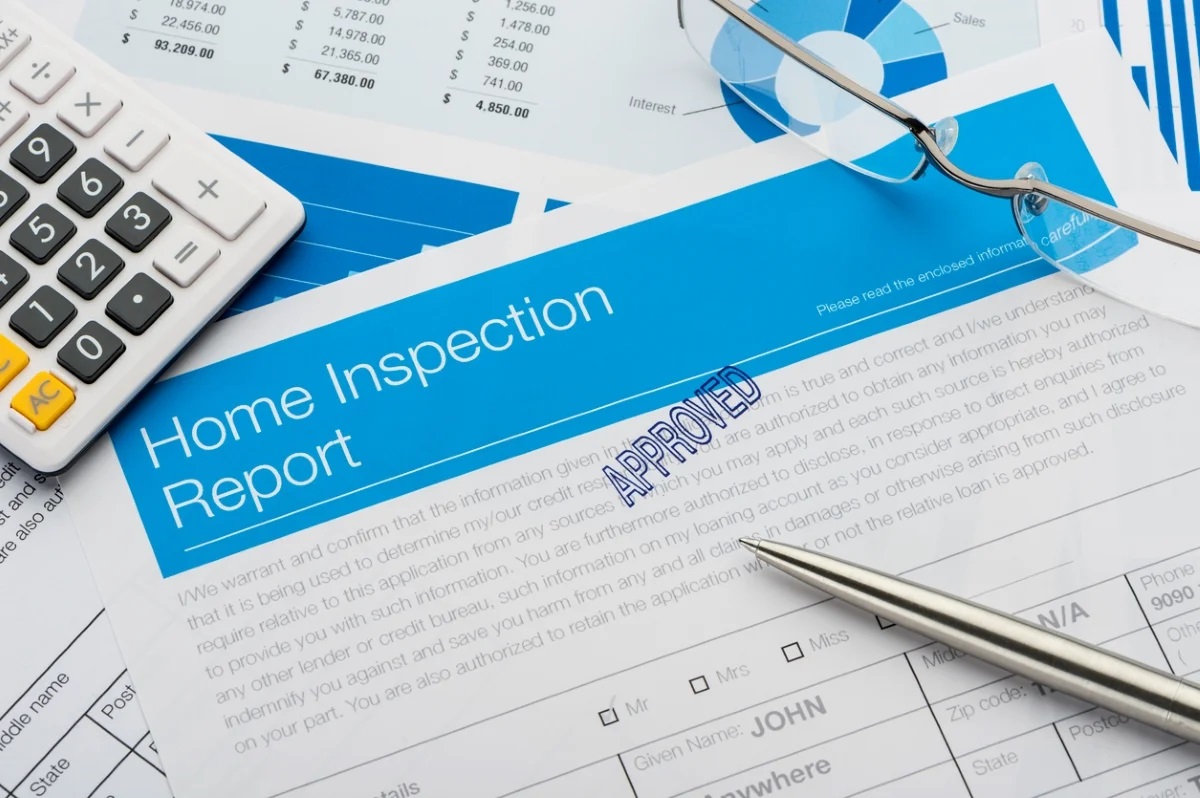Home>Home Maintenance>When Does A Buyer’s Agent Complete The Agent Visual Inspection Form?


Home Maintenance
When Does A Buyer’s Agent Complete The Agent Visual Inspection Form?
Modified: March 6, 2024
Learn when a buyer's agent completes the Agent Visual Inspection Form during the home maintenance process. Discover the importance of this step in ensuring a smooth buying experience.
(Many of the links in this article redirect to a specific reviewed product. Your purchase of these products through affiliate links helps to generate commission for Storables.com, at no extra cost. Learn more)
Introduction
Welcome to the world of home maintenance! Whether you’re a homeowner or a property investor, ensuring the upkeep of your house is essential to preserving its value and creating a safe and comfortable living environment. From routine maintenance tasks to tackling major repairs, taking care of your home can be a fulfilling yet challenging endeavor.
In this comprehensive guide, we will explore various aspects of home maintenance, offering expert advice, tips, and strategies to help you keep your property in top-notch condition. We’ll cover everything from routine cleaning and preventive maintenance to troubleshooting common problems and managing renovations.
Our goal is to equip you with the knowledge and resources you need to confidently handle different home maintenance tasks. Whether you’re a DIY enthusiast or prefer hiring professionals, this guide will serve as a valuable reference to support your efforts.
So, let’s dive in and discover the key areas of home maintenance that will help you protect your investment and create a comfortable living space for years to come.
Key Takeaways:
- Completing the Agent Visual Inspection Form early in the home buying process gives buyers the power to make informed decisions, negotiate effectively, and plan for necessary repairs, ensuring a smoother and faster closing process.
- Delaying the completion of the form can limit negotiation power, increase risks of undisclosed issues, and cause potential delays and unforeseen expenses, highlighting the importance of early completion for a stress-free home buying experience.
Purpose of the Agent Visual Inspection Form
When it comes to buying a home, the process can be complex and overwhelming. From finding the right property to navigating through negotiations and paperwork, there are numerous tasks and responsibilities involved. One crucial aspect of the home buying process is the visual inspection of the property.
The Agent Visual Inspection Form plays a vital role in this process. It is a document used by the buyer’s agent to record the condition of the property during the initial walkthrough. The purpose of this form is to document any visible defects or issues that may affect the value or livability of the home.
By completing the Agent Visual Inspection Form, the buyer’s agent provides essential information to the buyer, allowing them to make informed decisions about the purchase. This form serves as a detailed record of the property’s condition at the time of the inspection, providing a basis for further evaluation and negotiations.
The main purpose of the Agent Visual Inspection Form can be summarized as follows:
- Evaluating the condition of the property: The form allows the buyer’s agent to assess the overall condition of the property by documenting any visible defects or damages. This evaluation helps the buyer understand the potential maintenance or repair needs of the property.
- Identifying potential issues: The form helps in identifying any visible issues that may affect the value or livability of the property. This can include structural problems, plumbing or electrical issues, or cosmetic defects. Such information is crucial for the buyer to make an informed decision about the purchase.
- Negotiating repairs or concessions: The Agent Visual Inspection Form provides a reference point for negotiating repairs or concessions with the seller. If significant issues are identified during the inspection, the buyer can use this information to request repairs or financial adjustments to the purchase agreement.
- Protecting the buyer’s interests: By completing the form, the buyer’s agent acts as an advocate for the buyer, ensuring their interests are protected. The form serves as a documented proof of the property’s condition and can be referred to in case of any disputes or disagreements during the buying process.
Overall, the Agent Visual Inspection Form serves as a critical tool in the home buying process. It helps the buyer’s agent and the buyer themselves in evaluating the property, identifying potential issues, and protecting the buyer’s interests. Completing this form ensures transparency and facilitates effective communication between all parties involved in the transaction.
Understanding the Role of a Buyer’s Agent
Buying a home is a significant financial and emotional decision. It involves navigating through a complex process, which can be daunting for many buyers. That’s where a buyer’s agent comes in. A buyer’s agent is a real estate professional who represents the interests of the buyer throughout the home buying process.
The role of a buyer’s agent is multifaceted and encompasses several key responsibilities. Let’s explore some of the main aspects of their role:
- Market Knowledge: A buyer’s agent possesses in-depth knowledge of the local real estate market. They have access to information about the latest listings, market trends, and pricing data. This allows them to provide valuable guidance and help buyers make informed decisions about property value and negotiation strategies.
- Property Search: A buyer’s agent helps buyers find suitable properties based on their preferences and requirements. They conduct thorough market research, scouring listings, and utilizing their network to identify potential options. They save buyers time and effort by narrowing down the choices and presenting them with properties that align with their criteria.
- Negotiation: One of the most crucial roles of a buyer’s agent is negotiating on behalf of the buyer. They have experience in negotiating real estate transactions and are skilled at advocating for their client’s interests. They handle the back-and-forth with the seller’s agent, aiming to secure the best possible purchase price and favorable terms for the buyer.
- Contract Guidance: Buying a home involves extensive paperwork and legalities. A buyer’s agent guides their clients through the contract process, ensuring that they understand the terms and conditions. They review the contract, identify any potential issues, and work with the buyer’s attorney to protect their interests and ensure a smooth transaction.
- Inspection Assistance: A buyer’s agent helps coordinate property inspections, which are crucial for evaluating the condition of the home. They may recommend trusted home inspectors and accompany the buyer during the inspection to ensure that important areas are assessed. They then assist in interpreting the inspection report and advise the buyer on any necessary actions.
- Closing Support: The buyer’s agent remains involved in the transaction until the closing process. They help coordinate with lenders, attorneys, and other professionals involved in the transaction to ensure a timely and successful closing. They may also attend the closing with the buyer to address any last-minute concerns or questions.
Overall, a buyer’s agent serves as a trusted advisor and advocate for the buyer. They provide guidance, support, and expertise throughout the home buying journey, helping buyers navigate the process with confidence and peace of mind.
The Buyer’s Agent’s Responsibility in Completing the Form
When it comes to completing the Agent Visual Inspection Form, the responsibility primarily lies with the buyer’s agent. This form serves as a crucial tool in the home buying process, providing important information about the condition of the property. Let’s explore the buyer’s agent’s responsibilities in completing the form:
- Thorough Property Assessment: The buyer’s agent is responsible for conducting a detailed visual inspection of the property during the initial walkthrough. They should carefully examine each area of the home, both inside and outside, to identify any visible defects, damages, or issues that may affect the value or livability of the property. This assessment forms the basis for completing the form.
- Accurate Documentation: The buyer’s agent needs to accurately document any identified defects or issues on the Agent Visual Inspection Form. They should provide clear and concise descriptions of each item, specifying the location and nature of the problem. It’s important that the agent uses language that is easily understandable by the buyer, as they will rely on this information to make informed decisions.
- Attention to Detail: Completing the Agent Visual Inspection Form requires attention to detail. The buyer’s agent should be diligent in noting even minor issues that may seem insignificant but can still impact the value or condition of the property. This includes cosmetic defects, such as cracked tiles or chipped paint, as well as functional issues like leaky faucets or faulty electrical outlets.
- Objective Assessment: The buyer’s agent should approach the inspection and completion of the form with objectivity. They should focus on documenting factual information about the property’s condition rather than expressing personal opinions or judgments. This helps maintain transparency and ensures that the buyer receives an unbiased assessment of the property.
- Effective Communication: Completing the form is not just about documenting defects but also effective communication. The buyer’s agent should clearly communicate with the buyer, explaining the purpose and importance of the form. They should discuss any significant issues or concerns identified during the inspection, ensuring that the buyer fully understands the implications.
- Timely Completion: The buyer’s agent should aim to complete the Agent Visual Inspection Form within a reasonable timeframe. Ideally, this should be done shortly after the initial walkthrough, while the details are fresh in their mind. Timely completion ensures that the buyer has access to the information they need to make informed decisions and proceed with the home buying process.
By fulfilling these responsibilities, the buyer’s agent plays a crucial role in providing accurate and detailed information about the property’s condition. This empowers the buyer to make informed decisions, negotiate repairs or concessions if needed, and move forward confidently in their home buying journey.
Factors Affecting the Timing of the Inspection
The timing of the inspection plays a crucial role in the home buying process. It determines when the buyer’s agent completes the Agent Visual Inspection Form and provides the necessary information to the buyer. Several factors can influence the timing of the inspection. Let’s explore some of the key factors:
- Offer Acceptance: The timing of the inspection often depends on when the buyer’s offer is accepted. Once the offer is accepted, there is typically a specific timeframe, known as the inspection period, within which the buyer can conduct the inspection. The buyer’s agent should schedule the inspection accordingly to ensure it falls within this timeframe.
- Scheduling Availability: The availability of the property and involved parties, such as the buyer’s agent, seller’s agent, and home inspector, can impact the timing of the inspection. It may take some coordination to find a suitable time slot that works for everyone. The buyer’s agent should consider scheduling the inspection as soon as possible to avoid any delays.
- Property Access: The availability of the property for inspection is another factor to consider. If the property is occupied by the seller or tenants, the buyer’s agent needs to coordinate with them to gain access for the inspection. This may require negotiation and flexibility to align everyone’s schedules for a convenient inspection time.
- Property Condition: The existing condition of the property may influence the timing of the inspection. If the buyer has concerns about the condition or suspects potential issues, they may opt for an early inspection to address any significant problems before proceeding with the purchase. However, if the property is in good condition and the buyer wants to move forward quickly, they may opt for a later inspection to expedite the process.
- Market Conditions: Market conditions can also impact the timing of the inspection. In a competitive real estate market, buyers may need to act quickly and submit an offer without a specific inspection contingency. In such cases, the buyer’s agent may schedule the inspection immediately after offer acceptance to gather information and determine if further negotiations are necessary.
- Financing Contingencies: If the buyer’s offer is contingent on securing financing, the timing of the inspection can be influenced by the progress of the loan approval process. The buyer’s agent may coordinate with the lender to understand the timeline and schedule the inspection accordingly, ensuring the inspection falls within the contingency period.
Ultimately, the buyer’s agent needs to consider these factors and work closely with the buyer to determine the most suitable timing for the inspection. It’s important to balance the need for a thorough inspection with the overall timeline of the home buying process, ensuring timely completion of the Agent Visual Inspection Form for the buyer’s decision-making and negotiation purposes.
A buyer’s agent completes the Agent Visual Inspection Form after thoroughly inspecting the property with their client. This form helps document any issues or concerns about the property.
When to Complete the Agent Visual Inspection Form
The completion of the Agent Visual Inspection Form is a crucial step in the home buying process. It provides valuable information about the condition of the property and serves as a reference for the buyer’s decision-making and negotiation. The question arises: when is the ideal time to complete this form? Let’s explore the various scenarios:
- Early in the Process: Completing the Agent Visual Inspection Form early in the home buying process has its advantages. By conducting the inspection and completing the form soon after the initial walkthrough, the buyer gets a clear understanding of the property’s condition and any potential maintenance or repair needs. This early knowledge allows the buyer to make informed decisions about the purchase and negotiate any necessary repairs or concessions with the seller.
- During the Inspection Contingency Period: Many purchase agreements include an inspection contingency period, which gives the buyer the opportunity to conduct a thorough inspection of the property. Completing the Agent Visual Inspection Form during this period ensures that the buyer has ample time to assess the property’s condition and receive the inspection report before making a final decision. It allows the buyer to request repairs, negotiate price adjustments, or even potentially back out of the deal if significant issues are identified.
- Prior to Escrow or Closing: In some cases, due to various circumstances, the completion of the Agent Visual Inspection Form may be delayed until closer to the escrow or closing date. While not ideal, it is still important to complete the form before the transaction is finalized. This allows the buyer to have a clear understanding of the property’s condition and any necessary considerations before proceeding with the purchase.
- In Competitive Markets: In highly competitive real estate markets where multiple offers are common, buyers may choose to submit an offer without an inspection contingency. In such cases, the completion of the Agent Visual Inspection Form may occur after the offer is accepted. The purpose of completing the form in this scenario is to gather information about the property’s condition and determine if any further negotiations are necessary.
It’s important to note that the timing of completing the Agent Visual Inspection Form is a decision that should be made in consultation with the buyer’s agent. They will consider various factors such as the property’s condition, market conditions, contractual deadlines, and the buyer’s preferences to determine the most suitable timing. Open communication with the buyer and their agent ensures that the completion of the form aligns with the overall timeline and needs of the buyer.
In summary, it is generally recommended to complete the Agent Visual Inspection Form early in the home buying process or during the inspection contingency period. This allows the buyer to gather crucial information about the property’s condition and make informed decisions and negotiations. However, in certain circumstances, such as competitive markets or timing constraints, the completion of the form may be adjusted accordingly. Consulting with a trusted buyer’s agent will help determine the best approach for completing the form based on individual circumstances.
Benefits of Completing the Form Early
Completing the Agent Visual Inspection Form early in the home buying process offers several benefits for both the buyer and the buyer’s agent. By conducting the inspection and completing the form sooner rather than later, you can gain valuable insights into the condition of the property and make informed decisions. Let’s explore some of the key benefits:
- Informed Decision-Making: Completing the form early provides you with a clear understanding of the property’s condition. You can assess any visible defects, damages, or issues that may affect the value or livability of the home. Armed with this information, you can make informed decisions about the purchase, taking into account any necessary repairs or concessions.
- Negotiation Power: The early completion of the Agent Visual Inspection Form gives you a stronger position for negotiating with the seller. If significant issues are identified during the inspection, you have the opportunity to request repairs or price adjustments before finalizing the purchase. This can help you secure a better deal and protect your investment.
- Opportunity for Further Evaluation: Completing the form early allows you to identify potential issues that may require further evaluation. If the inspection uncovers major concerns, you can consult with specialized professionals, such as structural engineers or electricians, to assess the severity and potential cost of repairs. This deeper evaluation helps you make more informed decisions about the property.
- Peace of Mind: By completing the form early, you gain peace of mind knowing the condition of the property upfront. This knowledge reduces uncertainty and allows you to plan for any necessary repairs or improvements. It also ensures that you are fully aware of any potential maintenance needs, helping you transition smoothly into homeownership.
- Faster Transaction Process: Completing the form early can help expedite the overall transaction process. By addressing any issues early on, you can avoid delays that may occur if repair negotiations are prolonged. This ensures a smoother and faster closing, allowing you to move into your new home with minimal hassle.
- Stronger Understanding of Property Value: The early completion of the Agent Visual Inspection Form provides a comprehensive understanding of the property’s condition and potential value. You can factor in the necessary repairs or improvements when determining the true value of the home. This knowledge helps you assess whether the asking price aligns with the property’s condition and ensures you are making a sound investment.
Overall, completing the Agent Visual Inspection Form early offers numerous advantages. It empowers you to make informed decisions, negotiate from a position of strength, and plan for any necessary repairs or improvements. Consulting with your buyer’s agent and conducting the inspection as soon as possible after the initial walkthrough will help you maximize these benefits and navigate the home buying process with confidence.
Drawbacks of Completing the Form LateWhile completing the Agent Visual Inspection Form early in the home buying process offers several benefits, delaying its completion can have drawbacks. Waiting until later stages of the transaction to complete the form can result in missed opportunities and potential challenges. Let’s explore some of the drawbacks of completing the form late:
- Limited Negotiation Power: Completing the form late may limit your ability to negotiate repairs or concessions with the seller. By delaying the inspection, you may lose the opportunity to address significant issues before finalizing the purchase. This could result in additional expenses or missed chances to handle repairs under the seller’s responsibility.
- Higher Risk: The longer you wait to complete the form, the higher the risk of discovering unforeseen issues that could impact the property’s value or safety. Without the information provided by the Agent Visual Inspection Form, you may unknowingly take on a property with hidden defects or damages that could require significant investment down the line.
- Missed Evaluation Opportunities: Completing the form late may limit your ability to conduct further evaluations or consultations with specialized professionals. If the initial inspection reveals significant concerns, you may need additional time to bring in experts such as structural engineers or electricians to assess the severity of the issues. Delaying the completion of the form may limit the availability of these professionals or impede a thorough evaluation.
- Increased Stress and Uncertainty: Waiting to complete the inspection form can introduce unnecessary stress and uncertainty into the home buying process. Without a clear understanding of the property’s condition, you may face doubts and concerns about potential hidden issues. This can affect your confidence in the purchase and add unnecessary emotional strain.
- Potential Delays: Completing the form late may cause delays in the overall transaction process. If significant issues are identified that require repairs or further negotiations, the additional time needed to address these issues can prolong the closing process. This delay may impact your moving plans and create logistical challenges.
- Unforeseen Expenses: By delaying the completion of the form, you run the risk of encountering unexpected repair or maintenance costs that could have been identified earlier. The longer you delay, the higher the likelihood of unforeseen expenses arising once you take ownership of the property. This can strain your budget and disrupt your plans for your new home.
Overall, while it may be tempting to postpone the completion of the Agent Visual Inspection Form, it’s important to consider the potential drawbacks. Completing the form early in the home buying process provides numerous benefits and allows you to make informed decisions, negotiate effectively, and plan for necessary repairs or adjustments. Consulting with your buyer’s agent and prioritizing the completion of the form will help you navigate the process confidently and mitigate uncertainties and risks.
Common Industry Practices Regarding the Form Completion
When it comes to completing the Agent Visual Inspection Form, there are common industry practices that both buyers and buyers’ agents follow. These practices are designed to ensure transparency, facilitate effective communication, and protect the interests of all parties involved in the home buying process. Let’s explore some of the common industry practices regarding the form completion:
- Early Completion: It is generally recommended to complete the Agent Visual Inspection Form as early as possible in the home buying process. This allows buyers to gather crucial information about the property’s condition and make informed decisions. Early completion also provides sufficient time for further evaluations or negotiations if significant issues are identified.
- Thorough Assessment: Buyers’ agents are responsible for conducting a detailed visual inspection of the property to identify any visible defects or issues. They should document these findings accurately and provide clear descriptions of each item on the form. Thorough assessment ensures that buyers have a comprehensive understanding of the property’s condition.
- Buyer’s Review: After completing the Agent Visual Inspection Form, it is common for the buyer’s agent to review the findings and discuss them with the buyer. This review allows the buyer to ask questions, seek clarification, and fully understand the implications of any identified issues. The buyer’s agent should ensure that the buyer is well-informed and comfortable with the inspection results.
- Repair Negotiations: If significant issues are identified, it is common for the buyer’s agent to negotiate repairs or concessions with the seller. The Agent Visual Inspection Form serves as a reference point for these negotiations. The buyer’s agent may present the inspection findings to the seller’s agent and request necessary repairs or financial adjustments to address the identified issues.
- Resolution and Confirmation: Once the repair negotiations are completed, it is common for the buyer’s agent to ensure that the agreed-upon repairs are carried out satisfactorily. The buyer’s agent may coordinate with the seller’s agent or a designated representative to confirm that the repairs have been completed to the buyer’s satisfaction before moving forward with the purchase.
- Continued Monitoring: In some cases, additional inspections or evaluations may be necessary to address specific concerns. For example, if the initial inspection identifies potential structural issues, the buyer’s agent may recommend bringing in a structural engineer for further evaluation. This continued monitoring ensures that all issues are thoroughly assessed and resolved.
It’s important to note that industry practices may vary based on local regulations, contractual agreements, and the specific circumstances of each transaction. Your buyer’s agent will guide you through the process, adhering to the common practices while considering the unique aspects of your situation.
By following these common industry practices, buyers and buyers’ agents can navigate the form completion process effectively. This supports transparency, allows for informed decision-making, and helps to ensure a smooth and successful home buying experience for all parties involved.
Read more: How To Complete The Buyer’s Final Inspection
Conclusion
Completing the Agent Visual Inspection Form is a crucial step in the home buying process. It provides valuable information about the condition of the property and serves as a reference for decision-making and negotiation. By understanding the purpose of the form, the role of the buyer’s agent, and the factors affecting the timing of the inspection, buyers can effectively navigate the process and make informed decisions.
Completing the form early in the home buying journey offers numerous benefits. It allows buyers to make informed decisions, negotiate from a position of strength, plan for necessary repairs, and ensure a smoother and faster closing process. Early completion also provides peace of mind and a more comprehensive understanding of the property’s value.
On the other hand, delaying the completion of the form can have drawbacks. Buyers may experience limited negotiation power, higher risks of undisclosed issues, missed evaluation opportunities, increased stress, potential delays, and unforeseen expenses.
To adhere to common industry practices, it is recommended to complete the Agent Visual Inspection Form as early as possible. Buyers’ agents should conduct a thorough property assessment, communicate findings to buyers, facilitate repair negotiations if necessary, and ensure the agreed-upon resolutions are carried out satisfactorily.
By following these practices, buyers and buyers’ agents can work together to make informed decisions, protect buyers’ interests, and ensure a smooth home buying process. Remember, the completion of the Agent Visual Inspection Form is a crucial step in evaluating the condition of the property and making informed decisions. Consulting with a trusted buyer’s agent will help you navigate this process effectively and ultimately find your dream home.
Frequently Asked Questions about When Does A Buyer's Agent Complete The Agent Visual Inspection Form?
Was this page helpful?
At Storables.com, we guarantee accurate and reliable information. Our content, validated by Expert Board Contributors, is crafted following stringent Editorial Policies. We're committed to providing you with well-researched, expert-backed insights for all your informational needs.














0 thoughts on “When Does A Buyer’s Agent Complete The Agent Visual Inspection Form?”